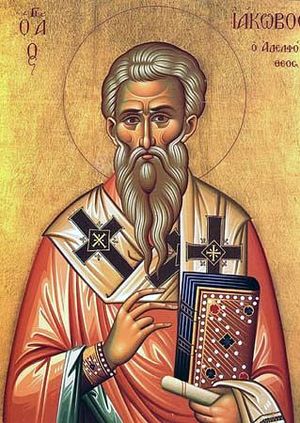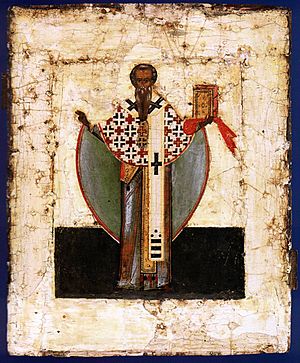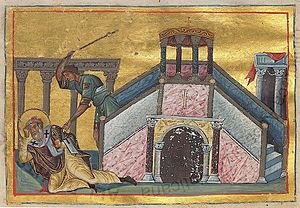James, brother of Jesus facts for kids
Quick facts for kids SaintJames the Just |
|
|---|---|

Neo-Byzantine icon of James
|
|
| Apostle and Martyr, Adelphotheos | |
| Born | Early 1st century |
| Died | 62 AD or 69 AD Jerusalem |
| Venerated in | All Christian denominations that venerate saints |
| Canonized | Pre-Congregation |
| Feast | May 3 (Catholic), May 1 (Anglican), October 23 (Lutheran), (Episcopal Church (USA)), (Eastern Orthodox), December 26 (Eastern Orthodox) |
| Attributes | Red martyr, fuller's club; man holding a book |
| Controversy | There is disagreement about the exact relationship to Jesus. |
James the Just was an important early Christian leader. He is known as "a brother of Jesus" according to the New Testament, which is a collection of books in the Christian Bible. He was a key leader of the first Christian community in Jerusalem.
Many believe James was killed for his faith around AD 62 or 69. He was ordered to be executed by the High Priest Ananus ben Ananus.
Some Christian groups, like Catholics and Eastern Orthodox Christians, believe that James and others called "brothers" of Jesus were not the biological children of Mary, mother of Jesus. They might have been Jesus's cousins or step-brothers from a previous marriage of Joseph.
It is generally agreed that James the Just is not the same person as James the Great, who was another important follower of Jesus.
Contents
Who Was James the Just?
James was called "the Just" because he was known for being very good and fair. An early Christian writer named Clement of Alexandria said that James was the first leader, or "bishop," of the church in Jerusalem. He was also called "James the Righteous."
In some Eastern Christian traditions, he is called "James Adelphotheos." This Greek name means "James the Brother of God." This title shows how important he was to early Christians. The oldest Christian worship service still used today, called the Liturgy of St James, uses this special name for him.
James as a Leader of the Jerusalem Church
The Early Jerusalem Church
The Jerusalem Church was one of the very first Christian communities. It was located in the city of Jerusalem. James and Peter were important leaders of this community. Many traditions say that James was the first bishop of Jerusalem. His important role in the city is mentioned in the Bible in Galatians 1:19.
During the siege of Jerusalem by the future Emperor Titus in 70 AD, the Jerusalem church moved to a place called Pella. After the siege, they returned to Jerusalem.
James's Leadership Role

James the Just became a main leader of the Church in Jerusalem. When Peter left Jerusalem, James became the most important person. He even led the important meeting known as the Council of Jerusalem.
The Bible books written by Paul (called the Pauline epistles) and the later parts of the Acts of the Apostles show that James was a very important figure. When Paul came to Jerusalem, he spoke directly with James. James asked Paul to perform a special cleansing ritual at Herod's Temple. This was to show that Paul still followed Jewish laws and to stop rumors that he was teaching against them.
Paul also wrote that James was one of the people to whom Jesus appeared after he rose from the dead (in 1 Corinthians 15:3–8). In another letter, Galatians 2:9, Paul called James, Peter, and John the Apostle the three "pillars" of the Church. This means they were considered the strongest and most important leaders.
James's Family Connection to Jesus
The Bible mentions Jesus's brothers: James, Jude, Simon, and Joses. Their names appear in Matthew 13:55 and Mark 6:3. James's name is always listed first, which might mean he was the oldest among them. An ancient historian named Josephus also described James as "the brother of Jesus who is called Christ."
There are different ideas about what "brother of the Lord" means:
- Younger Half-Brother: Some believe that James and the others were younger biological sons of Mary and Joseph. This means Mary and Joseph had more children after Jesus was born.
- Older Stepbrother: Other traditions, like the ancient Gospel of James, say that Joseph had children from an earlier marriage before he married Mary. In this case, James would have been Jesus's older stepbrother.
- Cousin: Many believe that James and the others were Jesus's cousins. In the language Jesus spoke, Aramaic, and in Biblical Hebrew, there wasn't a separate word for "cousin." So, "brother" or "sister" could also mean a close relative like a cousin.
The Catholic and Eastern Orthodox traditions teach that Mary remained a virgin her whole life. So, they believe that James and the others were not biological children of Mary.
The Death of James
According to early Christian writers, James was killed for his faith. Clement of Alexandria wrote that James "was thrown from the pinnacle of the temple, and was killed."
The historian Josephus also wrote about James's death. He said that James was killed in AD 62. The High Priest Ananus ben Ananus gathered a group of judges and condemned James for breaking the law. Then, James was executed. Josephus reported that many people thought this was unfair. They complained to the new Roman governor, and Ananus was removed from his position.
Some early writers, like Origen and Eusebius, even suggested that James's death was one of the reasons why the Romans later attacked and destroyed Jerusalem in AD 70.
Feast Days
Christians around the world remember and honor James the Just on special days:
- In the Catholic Church, his feast day is usually celebrated on May 3.
- In the Eastern Orthodox Church, James is honored on October 23, December 26, and January 4.
- The Episcopal Church (USA) and Lutheran Church also commemorate James on October 23.
- The Church of England remembers him on May 1.
See also
 In Spanish: Santiago el Justo para niños
In Spanish: Santiago el Justo para niños
- Divine Liturgy of Saint James
- List of biblical figures identified in extra-biblical sources
- Related Bible parts: Matthew 13, Matthew 27, Mark 6, Mark 15, Mark 16, Acts 12, Acts 15, Acts 21, 1 Corinthians 15, Galatians 1, Galatians 2; James 1; Epistle of Jude


